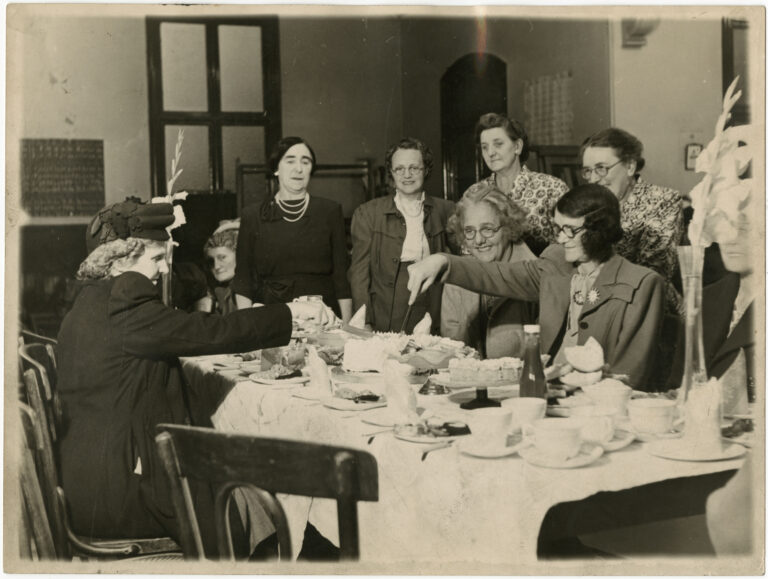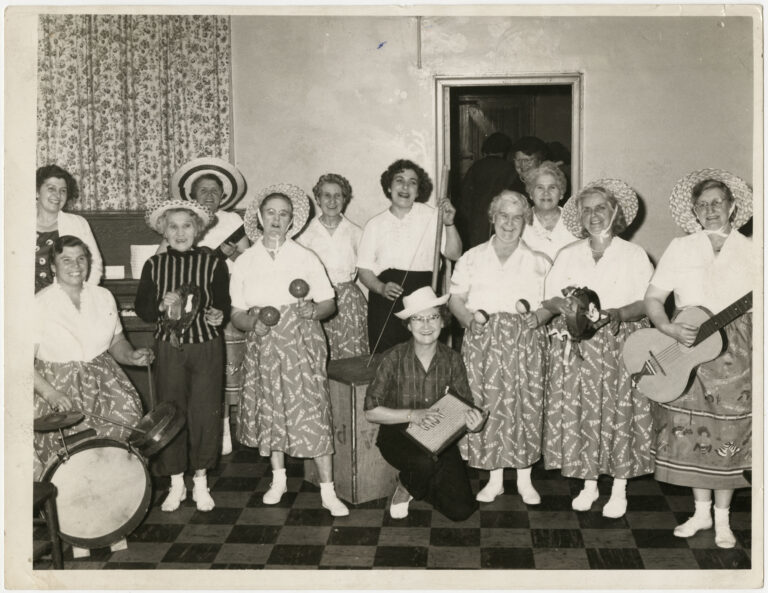Black and White Photographs of Women’s Sections, Taken About 1955
Reference: NRO 04415/1, 3, 5
Suggested age groups: KS1, KS2, KS3, KS4, Lifelong Learners
Subject areas: History, Literacy, Politics
CONTEXT
NRO 04415/4/1 Black and white photograph of the Northumberland Labour Women’s Advisory Council 21st birthday celebrations.
NRO 04415/4/3 Black and white photograph of Ashington Labour Women’s Skiffle Group paying a visit to The Ivy Branch, Ashington Co-operative Guild, Ashington, Northumberland.
NRO 04415/4/5 Black and white photograph of Ashington Labour Party Women’s Section at the Northumberland Miners’ Picnic at Bedlington, Northumberland.
In 1906 the Women’s Labour League (WLL) was founded by women to campaign for the vote. The WLL was linked (affiliated) to the Labour Party, which had been a political party since 1900. Lisbeth Simm, the daughter and wife of miners from Cramlington, became an organiser for the WLL in Newcastle and Northumberland. Ethel Bentham, Newcastle’s first female doctor, was also a member of the WLL.
In 1918, when parliament granted the vote to some women (but not on equal terms with men), the WLL became part of the Labour Party. The local branches of the WLL became Women’s Sections. At the county level women, were represented in the Labour Party by the Northumberland Labour Women’s Advisory Council. In turn, the Advisory Council sent delegates to the national women’s conference.
On a local level, a lot of the work carried out by the Women’s Sections involved fund raising and organising social events. As can be seen in the quote from Mildred Gordon, some women and probably a lot of men in the Labour movement disparaged the work of the Sections. They were often seen as cosy clubs that didn’t engage with larger political questions.
However, Sections offered women the chance to be part of a local and national organisation. Being part of this larger organisation also offered opportunities for travel, education, and socialising. In mining communities women were often excluded from pubs and working men’s clubs. Being part of this organisation also meant that women were better prepared to offer practical support at times of crisis. During strikes Women’s Sections often set up soup kitchens.
Women’s Sections held banners and paraded as part of the Miners’ Picnic.
What I think did happen was that the nature of women’s sections changed. Younger women, who were feminists, had previously ignored women’s sections and even opposed them because they appeared to be organizations of women who were happy to make the tea, raise funds, stuff toys for bazaars, and who saw that as their contribution to the party. They had a cosy social life, which was important to them, but they were not feminists, and did not take up questions of women’s rights, and in a sense their existence held back the fight for women’s rights.
Mildred Gordon “The Women’s Movement and the Labour Party – An interview with Labour Party feminists in The Feminist Review, Summer 1984, p 75-6
ACTIVITIES
ACTIVITY 1
Background
In 1906 the Women’s Labour League (WLL) was founded by women to campaign for the vote. The WLL was linked (affiliated) to the Labour Party, which had been a political party since 1900.
In 1918, when parliament granted the vote to some women (but not on equal terms with men), the WLL became part of the Labour Party. The local branches of the WLL became Women’s Sections. At the county level women, were represented in the Labour Party by the Northumberland Labour Women’s Advisory Council. In turn, the Advisory Council sent delegates to the national women’s conference.
SEE
See: When was the Women’s Labour League (WLL) founded?
See: What was the aim of the WLL when it was founded?
See: Which political party was the WLL linked to?
See: When did the WLL become part of the Labour Party?
See: What are Women’s Sections?
THINK
Think: Who was eligible to vote in the UK before 1918?
Think: Why didn’t women have the vote before 1918?
Think: When were all women given the vote?
Think: What is women’s suffrage?
Think: Who were the key figures involved in women’s suffrage?
Think: Is there anywhere in the world today where women don’t have the vote?
DO
Do: Create a timeline showing the journey to all women being given the vote.
Do: Create profiles for the key figures involved in women’s suffrage.
Do: Create a profile for the key figures who opposed women’s suffrage.
Do: Make a list of some of the reasons why women were not allowed to vote before 1918.
Do: Roleplay a debate between key figures who were pro and against women’s suffrage.
Do: Create a women’s suffrage protest banner.
Do: Create a map showing countries where women do not have the vote today.
Do: Create a map showing countries where women have the vote but face voter oppression or legal barriers which prevent them from using their vote.
Resources
https://www.museumoflondon.org.uk/discover/1918-election-first-time-women-voted
https://www.historic-uk.com/HistoryUK/HistoryofBritain/Votes-For-Women/
https://www.bl.uk/votes-for-women/articles/womens-suffrage-timeline
https://www.bl.uk/womens-rights/activities/the-campaign-for-womens-suffrage
https://worldpopulationreview.com/country-rankings/countries-where-women-cant-vote
ACTIVITY 2
Background
On a local level, a lot of the work carried out by the Women’s Sections involved fund raising and organising social events. As can be seen in the quote from Mildred Gordon, some women and probably a lot of men in the Labour movement disparaged the work of the Sections. They were often seen as cosy clubs that didn’t engage with larger political questions.
However, Sections offered women the chance to be part of a local and national organisation. Being part of this larger organisation also offered opportunities for travel, education, and socialising. In mining communities women were often excluded from pubs and working men’s clubs. Being part of this organisation also meant that women were better prepared to offer practical support at times of crisis. During strikes Women’s Sections often set up soup kitchens.
Women’s Sections held banners and paraded as part of the Miners’ Picnic.
SEE
See: What is shown in each of the photographs?
See: How were Women’s Sections involved in the mining community?
See: What work did Women’s Sections carry out on a local level?
See: Who was critical of the work carried out by Women’s Sections?
See: What was Mildred Gordon’s view on the work carried out by Women’s Sections?
THINK
Think: Why were some people critical of the work carried out by Women’s Sections?
Think: Why were women often excluded from leisure activities in the mining community?
Think: What types of support would Women’s Sections have provided in times of crisis?
Think: What types of crises were faced in the mining community?
Think: What did women do during miners’ strikes?
Think: What is the Labour Women’s Network?
DO
Do: Discuss why the Women’s Section might have comes across as more of a social group.
Do: Discuss why the Women’s Section might have comes across as more of a political group.
Do: Look at images of Women’s Section banners which were paraded at Miner’s Picnics.
Do: Discuss what you can learn about Women’s Sections from their banners.
Do: Design a Women’s Section banner.
Do: Analyse Mildred Gordon’s statement. What can you interpret about the work of Women’s Sections from the statement?
Do: Analyse Mildred Gordon’s statement. What can you interpret about people’s views on the work of Women’s Sections from the statement?
Do: Research the changing role of Women’s Sections over time. Write a response to Mildred Gordon’s statement based on what you learn.
Do: Write an article about the role of women during the 1984/5 miners’ strike.
Resources
OTHER ONLINE RESOURCES
Labour Women in Northumberland
Labour Women’s Network website, page about Great Labour Women: https://www.lwn.org.uk/great_labour_women
Northumberland Archives blog, article about Labour councillor for Morpeth, Dorothy Robson: https://northumberlandarchives.com/test/2021/03/18/dorothy-robson/
Northumberland Archives LEARN resource about Photo Centre (See section about Mrs BFC Adams, mayor of Berwick): https://northumberlandarchives.com/test/learn/photo-centre/women/
Reflections of Newcastle blog, article about Lisbeth Simm the the WLL: https://reflectionsofnewcastle.wordpress.com/2015/09/01/lisbeth-simm-and-the-womens-labour-league/
Labour Women
Labour Women’s Network website, page about Great Labour Women: https://www.lwn.org.uk/great_labour_women
Hexham Labour Party website, page for current women’s group: https://www.hexhamclp.org.uk/branches-and-groups/womens-group/
Women and the Miners’ Strike 1984/5
Independent Labour Party website, page about Anne Suddick, campaigner in Northumberland during the Miners’ Strike: https://www.independentlabour.org.uk/2021/01/21/the-pit-families-powerhouse-remembering-anne-suddick/
London School of Economics blog, article about exhibition of women’s role in miners’ strike: https://blogs.lse.ac.uk/lsehistory/2015/03/06/womens-librarylse-archive-women-and-the-miners-strike/
Guardian newspaper website, article about the role of women during the miners’ strike, 2014: https://www.theguardian.com/lifeandstyle/2014/apr/07/women-miners-strike-1984-wives-picket-lines
National Coalmining Museum online exhibition about women during the miners’ strike: https://www.coalfield-women.org/




